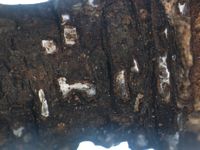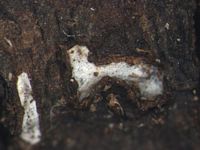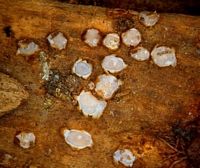|
 Propolis farinosa Propolis farinosa
SynonymsPropolis rhodoleuca
Propolomyces farinosus
Propolomyces versicolor
Stictis versicolor
Stictis farinosa
BiostatusPresent in region - Indigenous. Non endemic
Images (click to enlarge)
Owner: Herb PDD | 
Owner: Herb PDD | 
Owner: J.A. Cooper | 
Caption: Fig. 3 Propolomyces versicolor (PDD57912): A, margin of ascoma in vertical section. B,
asci. C, apex of asci and paraphyses. D, released ascospores. | 
Caption: Fig. 7 Propolomyces versicolor (PDD 57912): macroscopic appearance of ascoma. Scale = 1
mm. | 
Caption: FUNNZ: 2006/1491, See public note for more information
Owner: FUNNZ |
Article: Johnston, P.R. (1991). Rhytismataceae in New Zealand. 5. Wood- and bark-inhabiting species in the genera Colpoma and Propolomyces. New Zealand Journal of Botany 29: 405-410 (http://www.rsnz.org/publish/abstracts.php).
Description: Ascomata 1.5-3 x 0.5-1.5 mm, more or less oval to elliptic in outline, covered by a layer of
host and fungal tissue which breaks open by irregular radiate slits, and folds back as several
flaps to expose the white, pruinose hymenium. The covering flaps of tissue are blackened
below, concolorous with surrounding host tissue above.
Ascomata in vertical section with a poorly developed upper wall. The part of the wall
adjacent to the hymenium comprises 2-3 rows of hyaline, cylindric, 2-3 µm diam. cells, lined
with a layer of hyaline, cylindric, periphysis-like cells, forming a layer up to 20 µm wide. The
part of the wall which covers the hymenium before the ascomata open is 10-15 µm thick,
made up of 2-3 rows of brown, thick-walled, angular cells. A darkened lower wall is lacking,
the hyaline, hyphal tissue of the subhymenium resting directly on the partially broken down
host tissue.
Paraphyses with anastomoses near the bases, 1-2 µm diam., with several short side
branches near apex, forming a tangled epithecium, extending 20-30 µm beyond asci. Asci
100-120 x 11-15 µm, cylindric, rounded to subtruncate at apex, wall undifferentiated at apex,
8-spored, spores extending almost to base of ascus, ascus development sequential.
Ascospores 20-26 x 5-8 µm, oblong-elliptic in face view, characteristically slightly curved in
side view, 0-septate, hyaline, no gelatinous sheath.
Habitat: fallen wood of numerous plant species.
Distribution: Probably cosmopolitan, within New Zealand known from Auckland.
|